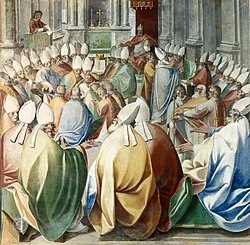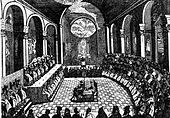
Back مجمع القسطنطينية الرابع Arabic مجمع القسطنطينيه الرابع ARZ Conceyu de Constantinopla de 869–870 AST Четвърти константинополски събор Bulgarian Concili IV de Constantinoble Catalan Čtvrtý konstantinopolský koncil Czech Viertes Konzil von Konstantinopel (869/870) German Τέταρτη Σύνοδος της Κωνσταντινούπολης (Καθολική Εκκλησία) Greek Concilio de Constantinopla de 869-870 Spanish Konstantinopolin neljäs kirkolliskokous Finnish
| Fourth Council of Constantinople (869–870) | |
|---|---|
 Cesare Nebbia's painting of the 869–870 Fourth Council of Constantinople | |
| Date | 869–870 |
| Accepted by | Catholic Church |
Previous council | Second Council of Nicaea |
Next council | First Council of the Lateran |
| Convoked by | Emperor Basil I and Pope Adrian II |
| President | papal legates |
| Attendance | 20–25 (first session 869), 102 (last session 870) |
| Topics | Photius' patriarchate |
Documents and statements | Deposition of Photius, 27 canons |
| Chronological list of ecumenical councils | |
| Part of a series on the |
| Ecumenical councils of the Catholic Church |
|---|
 |
| 4th–5th centuries |
| 6th–9th centuries |
| 12th–14th centuries |
| 15th–16th centuries |
| 19th–20th centuries |
|
|
The Fourth Council of Constantinople was the eighth ecumenical council of the Catholic Church held in Constantinople from 5 October 869, to 28 of February 870. It was poorly attended, the first session by only 12 bishops and the number of bishops later never exceeded 103.[1] In contrast the pro-Photian council of 879–80 was attended by 383 bishops.[2] The Council met in ten sessions from October 869 to February 870 and issued 27 canons.
The council was called by Emperor Basil I the Macedonian, with the support of Pope Hadrian II.[3] It deposed and anathemized Photius,[4] a layman who had been appointed as Patriarch of Constantinople, and reinstated his predecessor Ignatius.
The Council also reaffirmed the decisions of the Second Council of Nicaea in support of icons and holy images and required the image of Christ to have veneration equal with that of the gospel book.[5]
A later council, the Eastern Orthodox Fourth Council of Constantinople, was held after Photios had been reinstated on the order of the emperor. Today, the Catholic Church recognizes the council in 869–870 as "Constantinople IV", while the Eastern Orthodox Churches recognize the councils in 879–880 as "Constantinople IV" and revere Photios as a saint. Whether and how far the Greek Fourth Council of Constantinople was confirmed by Pope John VIII is a matter of dispute.[6][7][8] There is substantial evidence that he did in fact accept it, anathematising the council of 869 in his Letters to the Emperors Basil, Leo and Alexander, which were read in the second session of the 879/80 council,[9][10] his letter to Photios[11] [12] and his Commonitorium.[13][14] Francis Dvornik has argued that subsequent popes accepted the council of 879 as binding, only choosing the council of 869–70 as ecumenical 200 years later after the Great Schism due to issues with certain canons (namely the implicit condemnation of the filioque).[15] Siecienski disagrees with Dvornik's assessment.[16] The previous seven ecumenical councils are recognized as ecumenical and authoritative by both Eastern Orthodox and Catholic Christians.[17]
- ^ "Constantinople, Fourth Council of | Encyclopedia.com". www.encyclopedia.com. Retrieved 29 August 2021.
- ^ Richard Price, 'Constantinople III and Constantinople IV: Minorities posing as the Voice of the Whole Church', Annuarium Historiae Conciliorum 49 (2018/2019) 134.
- ^ "Photius." Cross, F. L., ed. The Oxford dictionary of the Christian church. New York: Oxford University Press. 2005
- ^ "Fourth Council of Constantinople". Papal Encyclicals. Retrieved 2023-10-08.
- ^ Steven Bigham, 1995 Image of God the Father in Orthodox Theology and Iconography ISBN 1-879038-15-3 p. 41
- ^ Fr. Francis Dvornik argues that Pope accepted the acts of the council and annulled those of the Council of 869–870. Other Catholic historians, such as Warren Carroll, dispute this view, arguing that the pope rejected the council.
- ^ Siecienski, Anthony Edward (2010) says that the Pope only gave a qualified assent to the acts of the council. See "The Filioque: History of a Doctrinal Controversy" p. 104.
- ^ Schaff, Philip opines that the Pope, deceived by his legates about the actual proceedings, first applauded the Emperor but later denounced the council. See "The Conflict of the Eastern and Western Churches and Their Separation."
- ^ Mansi vol xvii, cls. 400D & 401BC
- ^ Dositheos op. cit. pp. 281f
- ^ Mansi vol. xvii cl. 416E
- ^ Dositheos op. cit. p. 292
- ^ Mansi vol. xvii, cl. 472AB. See also cls. 489/490E
- ^ Dositheos op. cit. pp. 345, 361
- ^ Dvornik, F. (1948). "The Photian Schism in Western and Eastern Tradition". The Review of Politics. 10 (3): 310–331. doi:10.1017/S0034670500042959. JSTOR 1404567. S2CID 145772692.
- ^ Siecienski, Anthony Edward (2010). The Filioque: History of a Doctrinal Controversy. Oxford University Press. ISBN 9780195372045.
- ^ Parry, Ken; Melling, David J.; Brady, Dimitri; Griffith, Sidney H.; Healey, John F., eds. (2017-09-01) [1999]. "ecumenical councils". The Blackwell Dictionary of Eastern Christianity. Oxford, UK: Blackwell Publishing Ltd. pp. 171–2. doi:10.1002/9781405166584. ISBN 978-1-4051-6658-4.
© MMXXIII Rich X Search. We shall prevail. All rights reserved. Rich X Search